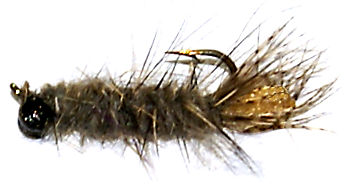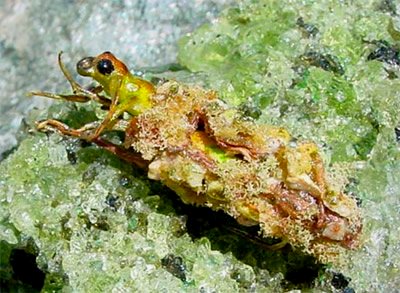Cream Peeping Cased Caddis Sedge Nymph
Research has shown that on many river systems caddis (Trichoptera) are a more important food source than mayflies. This is contrary to the fly fishermen’s common held belief that the mayfly is top of the aquatic menu for most trout.

CREAM PEEPING CASED CADDIS NYMPH PATTERN Hook size 12 - $US each
Fishing flies that imitate the caddis pupa are a comparatively recent innovation, while there is a very long history of fishermen using adult caddis dry fly patterns dating back to the 1400s. The underwater life of the Stillwater caddis was little understood until Dr J C Mottram published an article in 1914 along with a new caddis nymph fly pattern. As befits a good surgeon, he frequently investigated his trout’s stomach contents by using a sharp knife and analysed what they had been eating.
There are three main types of Caddis Larve, case builders, spinners, and roamers. The last two produce a silken strand like a spider. To prevent themselves being washed away when moving down fast flowing streams they will attach their line to a rock and then winch themselves down stream. This is when they are exposed to hungry trout. In times of very strong currents after rainfall all three types of caddis can be swept away and eaten by lurking predatory fish. The third type of Caddis Larva build a sticky tube around their body and then cover it in small stones, sand, silt, small sticks and other vegetable matter that is on the river bed. It is a clever way of camouflaging themselves so they blend in with their surroundings.
The case around their lower body is also believed to function as body armour as it protects them from small stones and other material hitting them in fast flowing water. It also means that no two cased caddis are identical. One end of the tube is open to allow the larva to poke its head and legs out. It uses its legs to hook onto rocks and vegetation to help it navigate around the river bed and feed. When it wants to move to a new area to find more food it lets go and floats with the current. Legs out ready to latch onto another rock, stick or leaf. Trout look out for the head and lighter body of the Caddis Larva sticking out from their protective casing. From experience they know that this is food floating past in a crunchy outer shell.

If you are going to a new fishing location carry a pot of superglue and some black green and cream waterproof marker pens in your fishing bag. I know this sounds strange but if you trawl the riverbed with a small net before you fish and find cased caddis that look different to the ones in your fly box coat your fly with some super glue and role it in the same coloured sand, dirt and gravel that covers the river bottom. This is a variation on ‘Matching the Hatch’. Make sure this material is dry before you stick it to your fly. Take it from the river bank or path. You can use the marker pens to alter the colour of the larva on your fly if necessary to match local insects.
CUSTOMER'S COMMENT
When I arrive on the water, during a summer fishing trip, and there is no activity on the surface I used to always tie on a pheasant tail nymph. One day I failed to restock my fly box and all I had in it was one of your cream peeping cased caddis. I gave it a try on point. What a revelation that was. I hooked into more than double the amount of trout and grayling I would expect to have caught using a Pheasant tail. I am not going to say this will work on every water but I knew this lake had a good late evening’s caddis hatch so there must have been an abundance of natural cased caddis on the bottom. The fish actively look for this food source. Ken Robson, Boston, USA


Fly Fishing books

